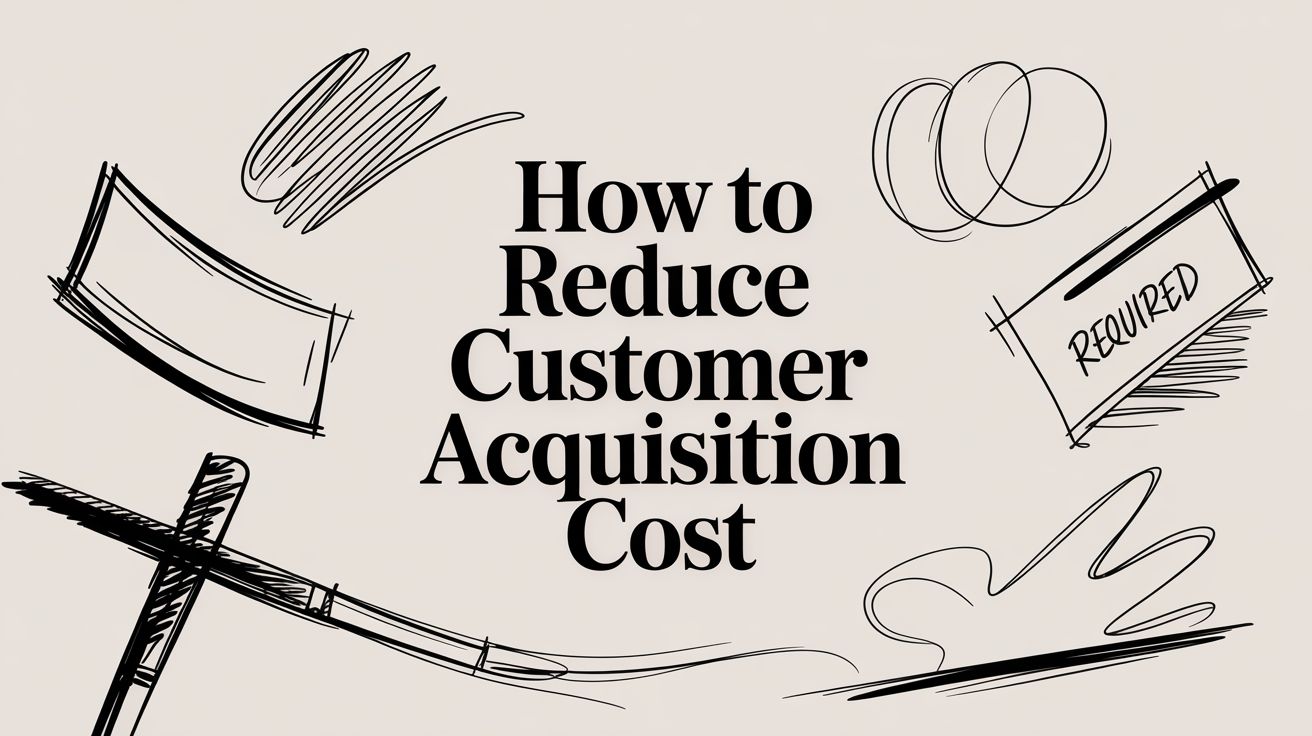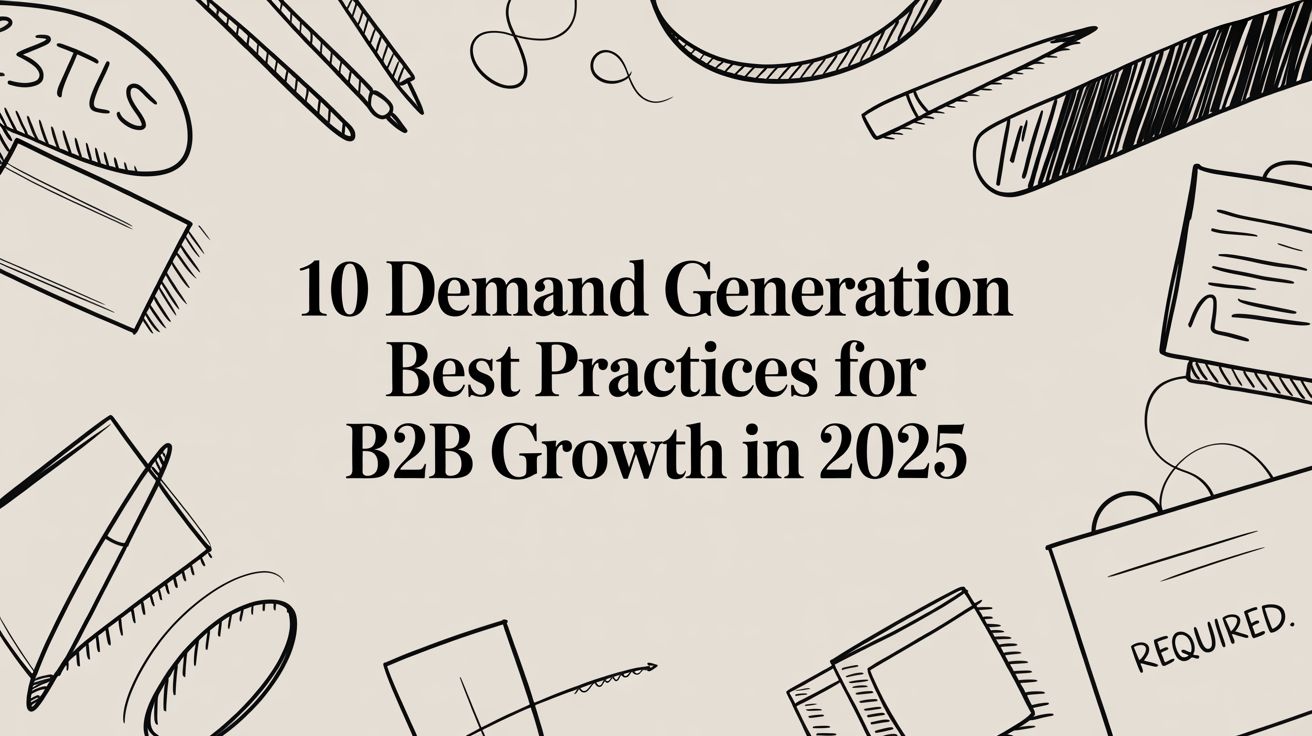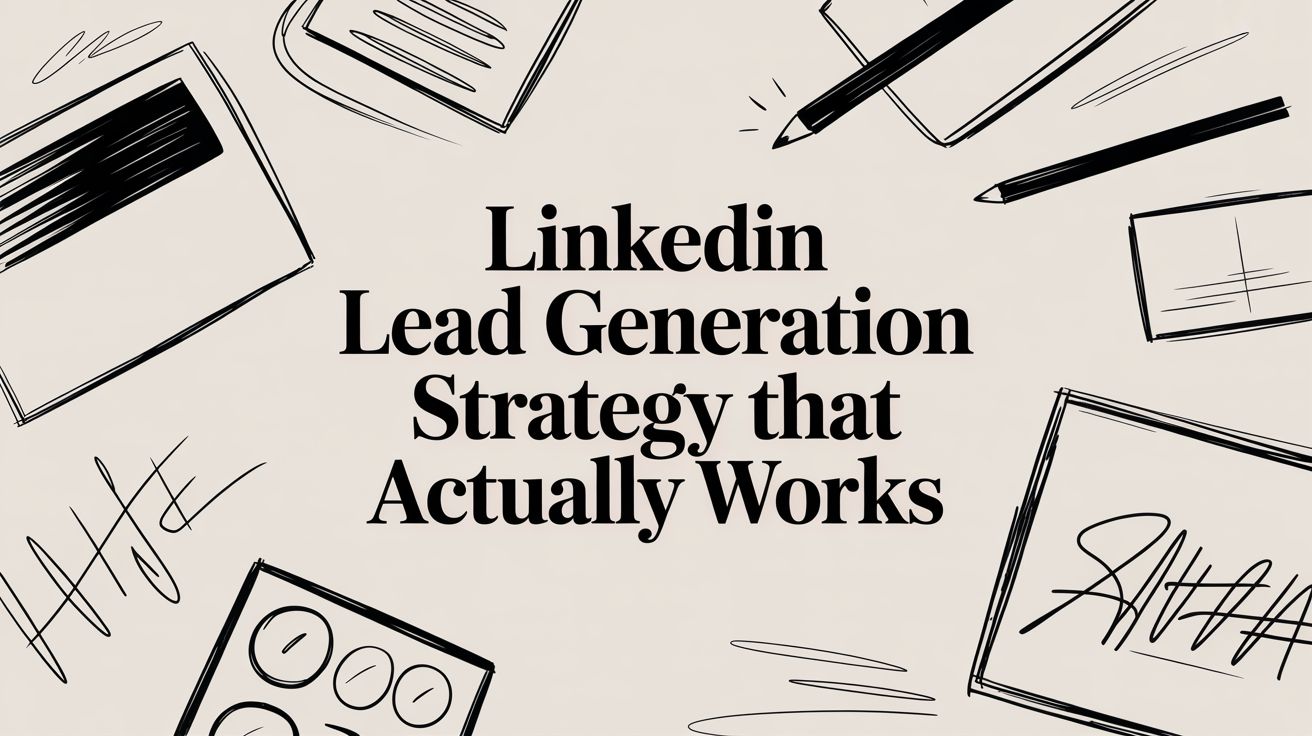You can’t fix a problem you don’t understand. This is especially true when it comes to customer acquisition costs. The first, most critical step in lowering your CAC is to stop guessing and start measuring. You need to calculate your true cost per customer, benchmark it against your industry, and then slice up the data to find the leaks in your marketing funnel.
Your Starting Point: Measuring and Benchmarking CAC
Before you touch a single campaign or write a line of new copy, you need a clear, brutally honest picture of what it currently costs you to win a new customer. Too many businesses fall into the trap of only looking at ad spend, which gives a dangerously misleading view.
A real CAC calculation is comprehensive. It has to include every single dollar you spend to get someone to sign on the dotted line.
Calculating Your True Customer Acquisition Cost
To nail down your actual CAC, you'll sum up all your sales and marketing expenses over a set period—say, a quarter—and then divide that total by the number of new customers you brought in during that same timeframe.
Make sure your expense total includes everything:
- Ad Spend: The obvious one—everything you pay to platforms like Google, Meta, LinkedIn, etc.
- Salaries: The portion of salaries for your marketing and sales teams focused on acquisition.
- Tools & Software: Your CRM, marketing automation, analytics platforms—any tech in your acquisition stack.
- Content & Creative: The costs for producing ads, blog posts, videos, and other assets.
- Overhead: A slice of general business costs that can be fairly allocated to sales and marketing.
If you skip any of these, you’re flying blind with a CAC that looks great on paper but masks real problems draining your budget. For a closer look at measuring the impact of this spending, our guide on https://replymer.com/blog/how-to-calculate-marketing-roi is a great resource.
Finding the Right Benchmarks
Okay, you’ve got your number. Now what? Is it good? Terrible? That’s where benchmarking comes in. Without context, your CAC is just a number floating in space.
The point of benchmarking isn’t just to see how you stack up—it’s to set a realistic baseline. This tells you if your costs are reasonable for your market or if you have a serious efficiency problem to tackle.
Start by looking at industry averages, because the cost to acquire a customer varies wildly from one sector to another. For instance, the e-commerce world has seen a massive shift in acquisition costs. The chart below shows just how much things have changed since 2013.

As you can see, it's getting more expensive for everyone. The average CAC in e-commerce has climbed to about $29 per new customer—a shocking 222% increase since 2013. This trend alone makes a smarter, more efficient acquisition strategy non-negotiable.
To really dig in, a solid guide on competitive benchmarking can show you how to measure your performance against direct rivals and spot opportunities they might be missing. Don’t forget to look inward, too. How has your own CAC changed over the past year? Spotting your internal trends is just as crucial as knowing where you stand in the market.
Key Metrics for Your CAC Reduction Dashboard
To keep all this information organized and actionable, you need a dashboard. Here are the core metrics you should be tracking to get a full picture of your acquisition health.
| Metric | What It Measures | Why It's Important for Lowering CAC |
|---|---|---|
| Overall CAC | The total cost to acquire a single new customer across all channels. | Your North Star metric. It gives you a high-level view of acquisition efficiency. |
| CAC by Channel | The specific cost to acquire a customer from each marketing channel (e.g., Google Ads, SEO, social). | Helps you identify your most and least profitable channels so you can reallocate your budget effectively. |
| LTV:CAC Ratio | The ratio of a customer's lifetime value to their acquisition cost. A healthy ratio is often cited as 3:1 or higher. | This tells you if you're acquiring profitable customers. A low ratio means you're overspending. |
| CAC Payback Period | The time it takes (in months) to recoup the cost of acquiring a customer through their revenue. | A shorter payback period means faster cash flow and a more sustainable growth model. |
| Conversion Rate by Funnel Stage | The percentage of users who move from one stage of your marketing funnel to the next. | Low conversion rates at any stage inflate your CAC. Pinpointing and fixing these weak spots is a direct path to lower costs. |
This dashboard isn't just about collecting data; it's about turning insights into action. By monitoring these KPIs, you can make informed decisions to systematically drive down your customer acquisition cost.
Driving Down Costs in Your Paid Ad Channels
Paid advertising is a classic double-edged sword. It can bring in customers faster than just about any other channel, but it can also burn through your budget at a terrifying pace if you're not careful. The secret to making paid ads work isn't just about spending money—it's about spending it with surgical precision. This is where you can turn your ad spend from a financial black hole into a highly efficient engine for growth.
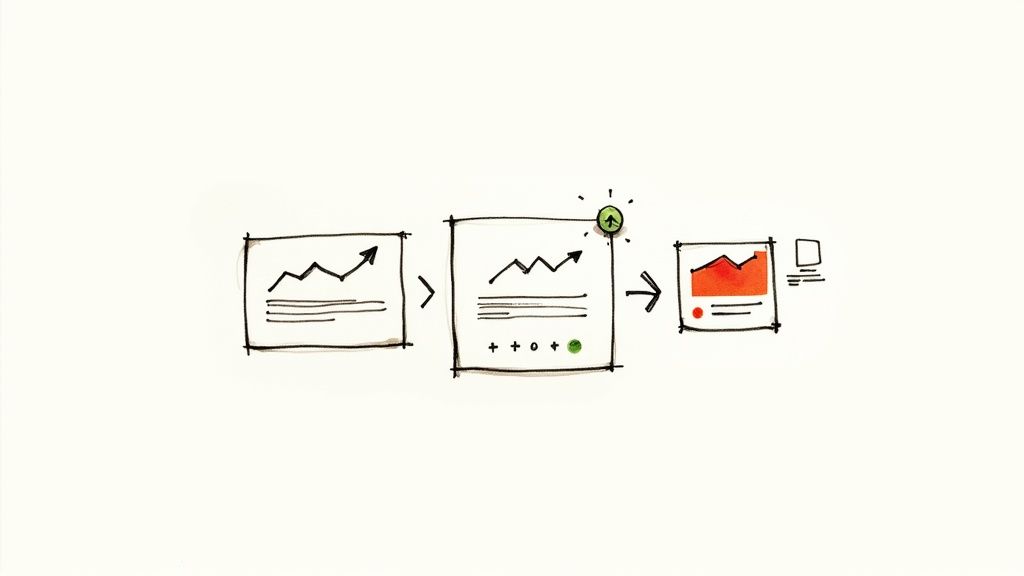
It all starts with a simple but critical idea: stop paying to reach the wrong people. Every single dollar you spend on an irrelevant click is a dollar down the drain. The real goal is to get your ads in front of people who already have a high intent to buy, and that requires a deep dive into your audience targeting.
Sharpen Your Audience Targeting
Generic, overly broad targeting is one of the quickest ways to send your CAC through the roof. Instead of blasting your ads to everyone who might be interested, you need to zero in on those who are most likely to pull out their wallet. This means going way beyond basic demographics and digging into the nitty-gritty of user behavior and intent.
Try refining your targeting with these approaches:
- Lookalike Audiences: These are gold. You’re essentially telling platforms like Meta or Google, "Go find me more people who look just like my best customers." Their algorithms are incredibly good at finding new users who share the same traits as people who've already converted.
- In-Market Audiences: This is about finding people who are actively shopping around. Google Ads is particularly powerful here, as it can identify signals that someone is deep in the research phase and ready to make a move on a product or service like yours.
- Segmented Retargeting: Don’t just hit every website visitor with the same generic ad. Break them down by what they did. Someone who abandoned a shopping cart is in a completely different mindset than someone who just skimmed a blog post—they need different messages to nudge them over the line.
This level of precision focuses your budget squarely on prospects who are much closer to a decision, which almost immediately improves your cost efficiency.
A Relentless Approach to A/B Testing
You should never, ever assume you know which ad copy, creative, or headline is going to crush it. The only real way to know is to test. And then test again. A structured A/B testing framework is non-negotiable for systematically boosting performance and chipping away at your CAC over time.
Think of your paid ad campaigns as a living laboratory, not a "set it and forget it" machine. Every test—win or lose—gives you valuable data that makes your next campaign smarter and more cost-effective.
The key is to start by testing just one variable at a time so you get clean, understandable results. For instance, pit two different headlines against each other while keeping the image and body copy identical. Once you have a clear winner, that becomes your new control, and you can move on to testing a different element, like the call-to-action (CTA).
Here’s a simple hierarchy I’ve seen work wonders:
- Test Big Ideas First: Start with the foundational stuff—major changes to your offer, your core value proposition, or your overall visual style.
- Move to Creative Elements: Next, experiment with different images, videos, or ad formats.
- Refine the Copy: Finally, dial in the details by testing headlines, body text, and CTAs.
This methodical approach creates a powerful cycle of continuous improvement, where every iteration gets you closer to a high-converting, low-cost ad.
Smart Bidding and Budget Allocation
How you bid and where you put your money are just as critical as who you target and what your ad says. Stop spreading your budget evenly across every campaign like you're buttering toast. Use your data to make confident, decisive moves about where to double down and where to pull back.
Get in the habit of analyzing your campaign performance regularly, focusing on metrics like Cost Per Conversion and Return on Ad Spend (ROAS). If a certain keyword, audience, or campaign is consistently delivering high-quality customers at a low cost, feed it more budget. On the flip side, don't be afraid to pause the underperformers that are just eating up your cash.
To see just how massive the impact of optimized paid ads can be, check out a case study where Google Ads generated over 21,000% ROI. It’s a perfect example of what happens when targeting, creative, and bidding all click into place. By actively managing your campaigns based on hard data, you ensure every dollar is working as hard as it possibly can to bring in customers profitably.
Improving Conversion Rates Across Your Funnel
Paying to get traffic to your website is only half the battle. The real magic in slashing your customer acquisition cost happens when you get more of those hard-won visitors to actually do something. Boosting your conversion rate is one of the most powerful levers you can pull, often without spending another dime on ads.
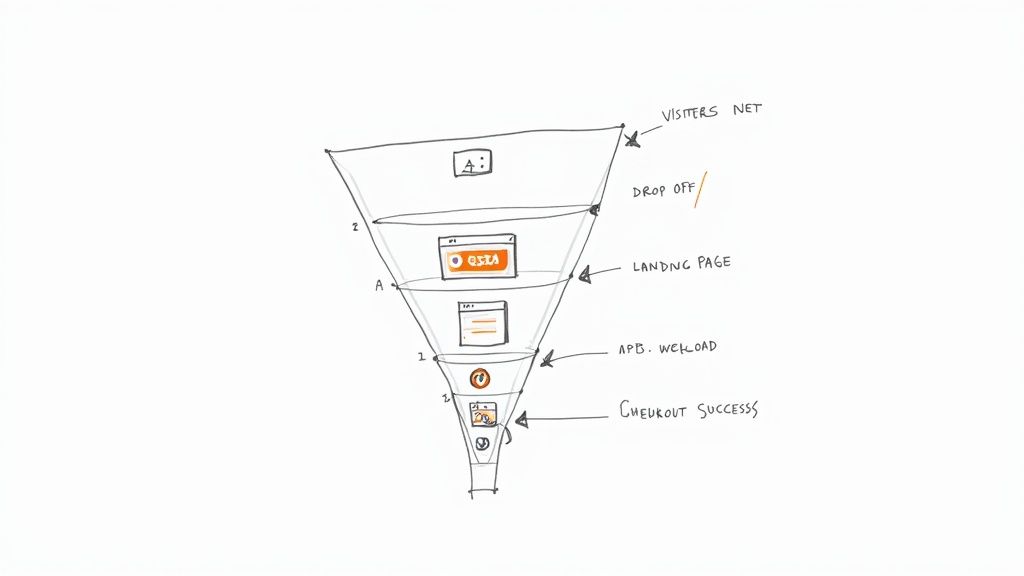
Think about it this way: if you double your conversion rate, you’ve effectively cut your cost per acquisition in half. This is the whole game behind Conversion Rate Optimization (CRO). It’s a systematic hunt for all the little points of friction that cause potential customers to leak out of your funnel.
Identifying and Removing Friction Points
Friction is anything that makes it harder for a user to get from point A to point B on your site. It could be a slow-loading page, a confusing form, or a button that’s nearly invisible. Each of these friction points is a hole in your bucket, costing you customers you already paid to attract.
The first step is to walk in your customer's shoes. Map out their critical journey on your site, from the moment they land on a page to the final thank-you message after a purchase. Then, start looking for roadblocks.
You'll often find the same culprits:
- Slow Page Load Speed: We're all impatient. If your site takes more than three seconds to load, people are leaving. Tools like Google PageSpeed Insights are your best friend for diagnosing these issues.
- Confusing Navigation: Can people find what they're looking for without thinking too hard? A clear, intuitive menu is non-negotiable.
- Complicated Forms: Every extra field in your signup or checkout process is another reason for someone to give up. Be ruthless—only ask for what is absolutely essential to get the job done.
Fixing these seemingly small issues can have an outsized impact on how many people make it all the way through your funnel.
Crafting a Compelling Value Proposition
Once you've cleared the path, you need to give people a powerful reason to walk down it. Your value proposition is a simple, punchy statement that answers three questions: what you do, who it's for, and why you're the best choice. This needs to be the first thing people see on your key landing pages.
A weak value proposition is a conversion killer. If a visitor can't figure out what you offer in about five seconds, they're gone.
A great value proposition isn't about listing features. It's about communicating the specific outcome or transformation a customer will experience. It answers their silent question: "What's in it for me?"
For example, instead of saying, "Our software has AI-powered analytics," try something like, "Our software shows you exactly which marketing channels are making you money." The second one speaks directly to a result they crave. That simple shift in language can make all the difference.
Optimizing Your Calls to Action
Your Call to Action (CTA) is the final gatekeeper between a visitor and a conversion. Vague, uninspired CTAs like "Submit" or "Click Here" create zero urgency or excitement. Your CTA button should feel like the obvious, compelling next step.
Here’s how to get your CTAs working harder:
- Use Action-Oriented Language: Start with a strong verb. "Get Your Free Demo" is miles better than "Learn More."
- Highlight the Value: What does the user get by clicking? "Start My 14-Day Free Trial" clearly communicates the immediate benefit.
- Create Contrast: Make your CTA buttons pop. They should stand out visually from everything else on the page with a bold, contrasting color.
These optimizations are crucial. Reducing CAC effectively hinges on this kind of efficiency. When the average CAC can be $76 for direct-to-consumer electronics or $91 for jewelry, even tiny improvements to a landing page can have a huge financial impact without touching your ad spend. You can find more industry insights on the connection between CAC and conversion rates on usermaven.com.
Making the customer journey smoother can also involve direct interaction. For instance, a well-placed chatbot can answer questions and guide users, which is a core tenet of conversational marketing. By actively addressing user concerns in real-time, you remove friction and build trust, directly lifting your conversion rates.
Building Your Organic and Referral Engines
Paid ads can get you traffic right away, but it's like renting an audience. The second you stop paying, the traffic disappears. If you want to build a truly sustainable business and bring your CAC down for good, you need channels that work for you 24/7, long after you've put in the initial effort. That’s where organic search and customer referrals come in.

Think of these two channels as a growth flywheel. You create fantastic content that solves a real problem, which pulls in organic traffic from search engines. This traffic turns into happy customers. Those happy customers then tell their friends, who become new customers… and the cycle repeats. It’s a self-perpetuating engine that slowly but surely reduces your dependency on pricey ads.
Master Problem-Solving SEO
Too many people think SEO is some dark art of stuffing keywords and chasing backlinks. It's not. At its core, great SEO is about one simple thing: solving your ideal customer’s problems better than anyone else.
When you create genuinely useful content, you’re making a long-term investment. That one piece of content can attract highly qualified traffic for years to come. This isn't about gaming Google's algorithm; it’s about becoming the go-to resource in your space.
Start by digging into the real questions and pain points your audience has. Sure, tools like Ahrefs or Semrush are great for this, but don't forget the low-tech approach. Go talk to your sales and support teams. Browse the Reddit communities or forums where your customers live.
Once you know what they're asking, create content that gives them a real answer:
- Actionable "How-To" Guides: Detailed walkthroughs that help readers accomplish a specific task.
- In-Depth Comparison Posts: Honestly compare different tools or solutions (including your own) to help them make an informed choice.
- Original Research & Case Studies: Share unique data or a compelling customer story that they can't find anywhere else.
The goal is to create something so valuable that a single blog post acts as a permanent, low-cost customer acquisition machine.
Turn Happy Customers into Your Best Sales Team
While SEO is busy pulling in new leads, a smart referral program gets your existing customer base to push your message out for you. Word-of-mouth is an absolute powerhouse because it comes with built-in trust. A recommendation from a friend will always be more credible than any ad you could ever run.
A well-designed referral program isn't a cost center—it's one of your most profitable acquisition channels. You're simply rewarding your best customers for finding you more customers just like them.
The numbers back this up, too. Customers acquired through referrals often cost 20-40% less and tend to have a higher lifetime value. It's a win-win.
Designing a Referral Program That Actually Works
A great program isn't just about the reward. It's about making the entire process dead simple for both the person referring and the person being referred.
Here are the key ingredients for a program that gets results:
- Give a Double-Sided Incentive: Don't just reward the referrer. Give a little something to the new customer, too. This "give a little, get a little" approach (e.g., you both get a $50 credit) makes the referrer feel generous, not greedy.
- Make the Rules Obvious: No one wants to read fine print. Use a simple landing page to clearly explain how it works, what the reward is, and how to share. Confusion is the enemy of action.
- Provide Effortless Sharing: Give them a unique referral link that’s easy to copy and paste. Add one-click sharing buttons for email, text, and social media. The fewer clicks, the better.
- Promote it Everywhere: Don't just launch your program and hope people find it. Weave it into your customer experience. Mention it in email newsletters, add a link in your app's dashboard, and have your support team bring it up.
By pairing a solid SEO strategy with a killer referral program, you create two powerful, complementary growth loops. One pulls in strangers by answering their questions, while the other empowers your happiest customers to spread the word. This is how you escape the paid ad treadmill and build a resilient, low-CAC business. To really get this flywheel spinning, you can explore these word-of-mouth marketing strategies for more ideas.
Using Tech and AI to Work Smarter, Not Harder
Let's be real: manual effort will only get you so far. If you're serious about scaling up customer acquisition without your costs spiraling out of control, you have to bring technology into the fold. Modern tools, especially those with AI baked in, are game-changers. They can automate the grunt work, personalize your outreach on a massive scale, and uncover insights you'd otherwise miss.
This isn’t about adding more expenses; it’s a strategic investment in efficiency. The right tech stack frees up your team from repetitive tasks so they can focus on what they do best—strategy, creativity, and building real human connections. The end goal is to make every marketing dollar and every single hour count for more.
This isn’t just a nice-to-have, either. It directly slashes your CAC. In fact, a staggering 88% of marketers are already using AI in their day-to-day. When done right, AI can cut your acquisition costs by up to 50% by creating hyper-relevant experiences that actually connect with people. You can dig into more of that data on how AI integration reduces acquisition costs over at genesysgrowth.com.
Put Your Lead Nurturing on Autopilot
Marketing automation is one of the lowest-hanging fruits here. Instead of having someone manually email every single person who downloads a resource, you can build smart workflows that guide them through the entire journey. Think of it as your tireless digital assistant, making sure no lead ever gets forgotten.
Here’s a simple, real-world example. A potential customer downloads your new ebook:
- Instantly, your automation platform adds them to a specific email list tagged with the ebook's topic (e.g., "interested in SEO").
- A few days later, it automatically sends a follow-up email with a related blog post or case study.
- If that same person then visits your pricing page three times in a week, the system can flag them as a hot lead and notify a sales rep.
This kind of systematic follow-up keeps the conversation going without you lifting a finger, warming up prospects until they're genuinely ready to talk. It’s the definition of doing more with less.
Use AI to Get Personal (at Scale)
The days of "one-size-fits-all" marketing are over. Your customers expect you to know who they are and what they need. AI makes that possible on a scale that would have been pure science fiction a decade ago. It can sift through mountains of data—browsing habits, purchase history, on-site behavior—to predict what a customer will want next.
Technology shouldn’t make your marketing feel more robotic; it should make it feel more human. Use AI to understand your customers so deeply that every interaction feels like a one-to-one conversation.
This is about much more than just sticking {{first_name}} in an email subject line. AI can power things like:
- Dynamic Website Content: Imagine showing different headlines or hero images to visitors from different industries.
- Predictive Lead Scoring: AI can analyze lead behavior and tell your sales team, "Hey, focus on this person, they're about to buy."
- Smarter Product Recommendations: Just like Amazon and Netflix, you can suggest exactly what a user is looking for before they even know it themselves.
This level of personalization doesn't just bump up conversion rates; it builds real brand loyalty that pays off in the long run.
Choosing the Right Tools for the Job
The MarTech landscape is a jungle. It's incredibly easy to get distracted by shiny new tools. The trick is to build a focused "tech stack" that solves your actual problems, not just to have the latest gadget.
Start by looking at your biggest bottlenecks. Where are things breaking down?
- Leads going cold? A marketing automation platform like HubSpot or ActiveCampaign is probably your answer.
- Ad campaigns underperforming? AI-powered ad management tools can find optimization opportunities you’d never spot on your own.
- Sales team wasting time on unqualified leads? A simple chatbot on your site can handle the initial screening 24/7.
By thoughtfully weaving technology and AI into your strategy, you build a smarter, more efficient acquisition engine. You're not just cutting CAC today—you're laying the groundwork for sustainable, long-term growth.
Focusing on Lifetime Value to Offset Acquisition Costs
A high Customer Acquisition Cost isn't automatically a red flag. In fact, it can be a sign of a healthy, growing business—but only if the customers you acquire stick around long enough to become profitable. This is where the playbook shifts from just winning new business to nurturing and expanding the relationships you already have.
The true health of your business isn't just a low CAC. It's the ratio between a customer's Lifetime Value (LTV) and what you paid to get them in the door. A high LTV gives you the freedom to spend more on acquisition, knowing that each new customer will pay back that initial investment and then some. You're not just making a sale; you're acquiring a long-term asset.
Master the First Impression with Onboarding
The first few days with your product are everything. It’s the make-or-break window where a new user decides if you're worth their time and money. A clunky or confusing onboarding experience is the fastest way to lose a customer you just paid good money to acquire.
Your onboarding shouldn't just be a tour of features. It needs to be a guided journey to that first "aha!" moment—the instant they experience your product's core value and realize, "This is exactly what I needed."
Here’s how to create an onboarding experience that sticks:
- Find the Quickest Win: What's the one action a new user can take to see immediate value? Build your entire onboarding flow around getting them there as quickly and smoothly as possible.
- Show the Path Forward: Use simple tools like checklists and progress bars. These give users a sense of accomplishment and a clear roadmap for what's next.
- Guide Them with Timely Emails: Don't just dump information. Send a sequence of helpful emails that offer tips, highlight relevant features, and celebrate their progress.
A great first impression proves your product’s value right out of the gate, setting the stage for a long-term relationship.
Grow Revenue with Smart Upselling and Cross-Selling
Once you have a happy, active customer, you have a prime opportunity to increase their LTV. Upselling (moving them to a more powerful plan) and cross-selling (offering a related product) are two of the best ways to do this, but they require a delicate touch.
Timing and relevance are crucial. Don't just bombard them with offers. Instead, watch for natural moments in their journey where an upgrade or add-on would genuinely help them.
A customer who consistently bumps up against the limits of their current plan isn't a problem—they're a perfect candidate for an upsell. Frame it not as a sales pitch, but as a helpful suggestion to unlock more value.
For example, if a user is about to run out of storage, a timely in-app notification suggesting an upgrade is a helpful nudge, not a hard sell. This approach feels supportive and adds real value, making customers more likely to invest further with you.
Turn Proactive Support into a Retention Tool
Never underestimate the power of outstanding customer support. When people run into trouble, they want it fixed—fast. But world-class support is proactive. It anticipates problems before they even happen.
This is where a strategic focus on retention really pays off. It’s smart to allocate around 53% of your marketing budget toward keeping existing customers, especially when you remember that acquiring a new customer can cost anywhere from 5 to 25 times more than retaining one. You can dig into the data on how budget allocation impacts retention on genesysgrowth.com.
By investing in proactive support and a fantastic customer experience, you drastically reduce churn. That directly increases your average LTV, which makes your original CAC look a whole lot more reasonable. Nurturing the entire customer journey is how you build a resilient, profitable business from the ground up.
At Replymer, we believe in turning authentic conversations into sustainable growth. Our done-for-you service finds the perfect discussions on Reddit, X (Twitter), and LinkedIn and places human-written, helpful replies that recommend your product naturally. Stop chasing expensive clicks and start building compounding demand with real dialogue. Discover how Replymer can reduce your acquisition costs and grow your business on autopilot.
